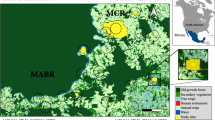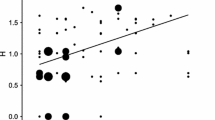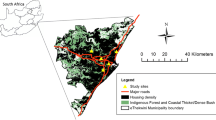Abstract
The degree to which habitat fragmentation affects bird incidence is species specific and may depend on varying spatial scales. Selecting the correct scale of measurement is essential to appropriately assess the effects of habitat fragmentation on bird occurrence. Our objective was to determine which spatial scale of landscape measurement best describes the incidence of three bird species (Pyriglena leucoptera, Xiphorhynchus fuscus and Chiroxiphia caudata) in the fragmented Brazilian Atlantic forest and test if multi-scalar models perform better than single-scalar ones. Bird incidence was assessed in 80 forest fragments. The surrounding landscape structure was described with four indices measured at four spatial scales (400-, 600-, 800- and 1,000-m buffers around the sample points). The explanatory power of each scale in predicting bird incidence was assessed using logistic regression, bootstrapped with 1,000 repetitions. The best results varied between species (1,000-m radius for P. leucoptera; 800-m for X. fuscus and 600-m for C. caudata), probably due to their distinct feeding habits and foraging strategies. Multi-scale models always resulted in better predictions than single-scale models, suggesting that different aspects of the landscape structure are related to different ecological processes influencing bird incidence. In particular, our results suggest that local extinction and (re)colonisation processes might simultaneously act at different scales. Thus, single-scale models may not be good enough to properly describe complex pattern–process relationships. Selecting variables at multiple ecologically relevant scales is a reasonable procedure to optimise the accuracy of species incidence models.


Similar content being viewed by others
References
Andrén H (1994) Effects of habitat fragmentation on birds and mammals in landscapes with different proportions of suitable habitat: a review. Oikos 71:355–366. doi:10.2307/3545823
Bakker KK, Naugle DE, Higgins KF (2002) Incorporating landscape attributes into models for migratory grassland bird conservation. Conserv Biol 16:1638–1646. doi:10.1046/j.1523-1739.2002.01328.x
Beier P, van Drielen M, Kankam BO (2002) Avifaunal collapse in West African forest fragments. Conserv Biol 16:1097–1111. doi:10.1046/j.1523-1739.2002.01003.x
Bernacci LC, Franco GADC, Árbocz GF, Catharino ELM, Durigan G, Metzger JP (2006) O efeito da fragmentação florestal na composição e riqueza de árvores na região da reserva Morro Grande (planalto de Ibiúna, SP). Rev Inst Flor 18:121–166
Boscolo D (2007) Influência da estrutura da paisagem sobre a persistência de três espécies de aves em paisagens fragmentadas da Mata Atlântica. Dissertation, University of São Paulo, Brazil. Available in English from http://www.teses.usp.br/teses/disponiveis/41/41134/tde-13022008-180423/. Accessed 10 June 2009
Boscolo D, Metzger JP, Vielliard JME (2006) Efficiency of playback for assessing the occurrence of five bird species in Brazilian Atlantic Forest fragments. An Acad Bras Cienc 78:629–644. doi:10.1590/S0001-37652006000400003
Boscolo D, Candia-Gallardo C, Awade M et al (2008) Importance of inter-habitat gaps and Stepping-stones for lesser woodcreepers (Xiphorhynchus fuscus) in the Atlantic Forest, Brazil. Biotropica 40:273–276. doi:10.1111/j.1744-7429.2008.00409.x
Brooke MD (1983) Ecological segregation of woodcreepers (Dendrocolaptidae) in the state of Rio-De-Janeiro, Brasil. Ibis 125:562–567. doi:10.1111/j.1474-919X.1983.tb03150.x
Brooker M, Brooker L (2001) Breeding biology, reproductive success and survival of blue-breasted fairy-wrens in fragmented habitat in the western Australian wheatbelt. Wildl Res 28:205–214. doi:10.1071/WR00012
Brotons L, Thuiller W, Araujo MB et al (2004) Presence-absence versus presence-only modelling methods for predicting bird habitat suitability. Ecography 27:437–448. doi:10.1111/j.0906-7590.2004.03764.x
Castelletta M, Thiollay JM, Sodhi NS (2005) The effects of extreme forest fragmentation on the bird community of Singapore Island. Biol Conserv 121:135–155. doi:10.1016/j.biocon.2004.03.033
Clergeau P, Burel F (1997) The role of spatio-temporal patch connectivity at the ladscape level: an example in a bird distribution. Landsc Urban Plan 38:37–43. doi:10.1016/S0169-2046(97)00017-0
Cushman SA, McGarigal K (2004) Patterns in the species-environment relationship depend on both scale and choice of response variables. Oikos 105:117–124. doi:10.1111/j.0030-1299.2004.12524.x
Davis DE (1945) The annual cycle of plants, mosquitoes, birds, and mammals in 2 Brazilian forests. Ecol Monogr 15:243–295. doi:10.2307/1943247
del Hoyo J, Elliott A, Christie DA (eds) (2003a) Handbook of the birds of the world. vol. 8. Broadbills to Tapaculos. Lynx Edicions, Barcelona
del Hoyo J, Elliott A, Christie DA (eds) (2003b) Handbook of the birds of the world. Vol 9. Cotingas to Pipits and Wagtails. Lynx Edicions, Barcelona
Deleo JM (1993) Receiver operating characteristic laboratory (ROCLAB): software for developing decision strategies that account for uncertainty. In: IEE (ed) Proceedings of the second international symposium on uncertainty modeling and analysis. Computer Society Press, College Park
Develey PF (1997). Ecologia de bandos mistos de aves de Mata Atlântica na estação Ecológica Juréia Itatins. Dissertation, University of São Paulo
Develey PF, Peres CA (2000) Resource seasonality and the structure of mixed species bird flocks in a coastal Atlantic forest of southeastern Brazil. J Trop Ecol 16:33–53. doi:10.1017/S0266467400001255
Develey PF, Metzger JP (2006) Emerging threats to birds in Brazilian Atlantic forests: the roles of forest loss and configuration in a severely fragmented ecosystem. In: Laurance WF, Peres CA (eds) Emerging threats to tropical forests. University of Chicago Press, Chicago, pp 269–290
dos Anjos L, Boçon R (1999) Bird communities in natural forest patches in southern Brazil. Wilson Bull 111:397–414
Durigan G, Bernacci LC, Franco GADC, Arbocz GF, Metzger JP, Catharina ELM (2008) Estádio sucessional e fatores geográficos como determinantes da similaridade florística entre comunidades florestais no Planalto Atlântico, Estado de São Paulo, Brasil. Acta bot bras 22:51–62
Efron B (1979) Bootstrap methods: another look at the jackknife. Stat 7:1–26
Ewers RM, Didham R (2006) Confounding factors in the detection of species responses to habitat fragmentation. Biol Rev Camb Philos Soc 81:117–142. doi:10.1017/S1464793105006949
Fahrig L (2003) Effects of habitat fragmentation on biodiversity. Annu Rev Ecol Evol Syst 34:487–515. doi:10.1146/annurev.ecolsys.34.011802.132419
Ferraz G, Nichols JD, Hines JE, Stouffer PC, Bierregard RO Jr, Lovejoy TE (2007) A large-scale deforestation experiment: effects of patch area and isolation on Amazon birds. Science 315:238–241. doi:10.1126/science.1133097
Fielding AH, Haworth PF (1995) Testing the generality of bird-habitat models. Conserv Biol 9:1466–1481. doi:10.1046/j.1523-1739.1995.09061466.x
Foster MS (1981) Cooperative behavior and social organization of the Swallow-tailed Manakin (Chiroxiphia caudata). Behav Ecol Sociobiol 9:167–177. doi:10.1007/BF00302934
Fuhlendorf SD, Woodward AJW, Leslie DM et al (2002) Multi-scale effects of habitat loss and fragmentation on lesser prairie-chicken populations of the US Southern Great Plains. Landscape Ecol 17:617–628. doi:10.1023/A:1021592817039
Goerck JM (1999) Distribution of birds along an elevational gradient in the Atlantic forest of Brazil: implications for the conservation of endemic and endangered species. Bird Life Int 9:235–253
Gomes VSM, Alves VS, Ribeiro JRI (2001) Íntens alimentares encontrados em amostras de regurgitação de Pyriglena leucoptera (Vieillot) (Aves, Thamnophilidae) em uma floresta secundária no Estado do Rio de Janeiro. Rev Bras Zool 18:1073–1079
Goodwin BJ, Fahrig L (2002) How does landscape structure influence landscape connectivity? Oikos 99:552–570. doi:10.1034/j.1600-0706.2002.11824.x
Graf RF, Bollmann K, Suter W et al (2005) The importance of spatial scale in habitat models: capercaillie in the Swiss Alps. Landscape Ecol 20:703–717. doi:10.1007/s10980-005-0063-7
Green R (1979) Sampling design and statistical methods for environmental biologists. Wiley, New York
Gutzwiller KJ, Anderson SH (1987) Multiscale associations between cavity-nesting birds and features of Wyoming streamside woodlands. Condor 89:534–548. doi:10.2307/1368643
Hansbauer MM, Storch I, Pimentel RG, Metzger JP (2008) Comparative range use by three Atlantic Forest understory bird species in relation to forest fragmentation. Trop Ecol J 24:291–299
Hanski I (1994) A practical model of metapopulation dynamics. J Anim Ecol 63:151–162. doi:10.2307/5591
Harrell FE (2001) Regression modeling strategies. Springer, Berlin
Heinz SK, Conradt L, Wissel C et al (2005) Dispersal behaviour in fragmented landscapes: deriving a practical formula for patch accessibility. Landscape Ecol 20:83–99. doi:10.1007/s10980-004-0678-0
Jaquet N (1996) How spatial and temporal scales influence understanding of Sperm Whale distribution: a review. Mammal Rev 26:51–65. doi:10.1111/j.1365-2907.1996.tb00146.x
Lawler JJ, Edwards TC Jr (2002) Landscape patterns as habitat predictors: building and testing models for cavity-nesting birds in the Uinta Mountains of Utah, USA. Landscape Ecol 17:233–245. doi:10.1023/A:1020219914926
Levin SA (1992) The problem of pattern and scale in ecology. Ecology 73:1943–1967. doi:10.2307/1941447
Li H, Wu J (2007) Landscape pattern analysis: key issues and challenges. In: Wu J, Hobbs RJ (eds) Key topics in landscape ecology. Cambridge University Press, Cambridge, pp 39–61
Lindenmayer DB (2000) Factors at multiple scales affecting distribution patterns and their implications for animal conservation—Leadbeater’s Possum as a case study. Biodivers Conserv 9:15–35. doi:10.1023/A:1008943713765
Lindenmayer DB, McCarthy MA, Pope ML (1999) Arboreal marsupial incidence in eucalypt patches in south-eastren Australia: a test of Hanski’s incidence function metapopulation model for patch occupancy. Oikos 84:99–109. doi:10.2307/3546870
Major RE, Christie FJ, Gowing G et al (1999) Age structure and density of red-capped robin populations vary with habitat size and shape. J Appl Ecol 36:901–908. doi:10.1046/j.1365-2664.1999.00457.x
Maldonado-Coelho M, Marini MÂ (2000) Effects of forest fragment size and successional stage on mixed-species bird flocks in southeastern Brazil. Condor 102:585–594. doi:10.1650/0010-5422(2000)102[0585:EOFFSA]2.0.CO;2
Manning AD, Lindenmayer BD, Barry SC et al (2006) Multi-scale site and landscape effects on the vulnerable superb parrot of south-eastern Australia during the breeding season. Landscape Ecol 21:1119–1133. doi:10.1007/s10980-006-7248-6
Martensen AC, Pimentel RG, Metzger JP (2008) Relative effects of fragment size and connectivity on bird community in the Atlantic rain forest: implications for conservation. Biol Conserv 141:2184–2192. doi:10.1016/j.biocon.2008.06.008
Martínez JA, Serrano D, Zuberogoitia I (2003) Predictive models of habitat preferences for the Eurasian eagle owl Bubo bubo: a multiscale approach. Ecography 26:21–28. doi:10.1034/j.1600-0587.2003.03368.x
Mazerolle MJ, Villard MA (1999) Patch characteristics and landscape context as predictors of species presence and abundance: a review. Ecoscience 6:117–124
McGarigal K, Marks BJ (1995) FRAGSTATS: spatial pattern analysis program for quantifying landscape structure. USDA For. Serv. Gen. Tech. Rep. PNW-351
Melo-Júnior TA, Vasconcelos MF, Fernandes W et al (2001) Bird species distribution and conservation in serra do cipó, Minas Gerais, Brazil. Bird Life Int 11:189–204
Metzger JP (1998) Estrutura da paisagem e fragmentação: análise bibliográfica. An Acad Bras Cienc 71:445–463
Metzger JP, Décamps H (1997) The structural connectivity threshold: an hypothesis in conservation biology at the landscape scale. Acta Ecol 18:1–12
Meyer CB, Thuiller W (2006) Accuracy of resource selection functions across spatial scales. Divers Distrib 12:288–297. doi:10.1111/j.1366-9516.2006.00241.x
Neel MC, McGarigal K, Cushman SA (2004) Behavior of class-level landscape metrics across gradients of class aggregation and area. Landscape Ecol 19:435–455. doi:10.1023/B:LAND.0000030521.19856.cb
Oliveira-Filho AT, Fontes MAL (2000) Patterns of floristic differentiation among Atlantic Forests in southeastern Brazil and influence of climate. Biotropica 32:793–810
R Development Core Team (2005) R: a language and environment for statistical computing. R Foundation for Statistical Computing, Vienna
Rahbek C, Graves GR (2001) Multiscale assessment of patterns of avian species richness. Proc Natl Acad Sci USA 98:4534–4539. doi:10.1073/pnas.071034898
Renfrew RB, Ribic CA (2008) Multi-scale models of grassland passerine abundance in a fragmented system in Wisconsin. Landscape Ecol 23:181–193. doi:10.1007/s10980-007-9179-2
Ribeiro MC, Metzger JP, Martensen AC, Ponzoni FJ, Hirota MM (2009) Brazilian Atlantic forest: how much is left and how is the remaining forest distributed? Implications for conservation. Biol Conserv 142:1141–1153. doi:10.1016/j.biocon.2009.02.021
Roberts DL, Cooper RJ, Petit LJ (2000) Use of premontane moist forest and shade coffe agroecosystems by army ants in western Panama. Conserv Biol 14:192–199. doi:10.1046/j.1523-1739.2000.98522.x
Ross JLS, Moroz IC (1997) Mapa Geomorfológico do Estado de São Paulo, escala 1:500.000. Volume 1. Geografia-FFLCH-USP, IPT and Fapesp, Sao Paulo
Sekercioğlu ÇH, Ehrlich PR, Daily GC et al (2002) Disappearance of insectivorous birds from tropical forest fragments. Proc Natl Acad Sci USA 99:263–267. doi:10.1073/pnas.012616199
Sick H (1997) Ornitologia Brasileira. Editora Nova Fronteira, Rio de Janeiro
Snow DW (1976) The web of adaptation. Quadrangle/The New York Times Book Co., New York
Soares ES, dos Anjos L (1999) Efeito da fragmentação florestal sobre aves escaladoras de tronco e galho na região de Londrina, norte do estado do Paraná, Brasil. Ornitol Neotrop 10:61–68
Stotz DF, Fitzpatrick JW, Parker TAIII, Moskovits DK (1996) Neotropical birds: ecology and conservation. The University of Chicago Press, Chicago
Stratford JA, Stouffer PC (1999) Local extinctions of terrestrial insectivorous birds in a fragmented landscape near Manaus, Brazil. Conserv Biol 13:1416–1423. doi:10.1046/j.1523-1739.1999.98494.x
Taylor PD, Fahrig L, Henein K et al (1993) Connectivity is a vital element of landscape structure. Oikos 68:571–573. doi:10.2307/3544927
Thompson WL (2002) Towards reliable bird surveys: accounting for individuals present but not detected. Auk 119:18–25. doi:10.1642/0004-8038(2002)119[0018:TRBSAF]2.0.CO;2
Thompson CM, McGarigal K (2002) The influence of research scale on bald eagle habitat selection along the lower Hudson River, New York (USA). Landscape Ecol 17:569–586. doi:10.1023/A:1021501231182
Uezu A, Metzger JP, Vielliard JME (2005) Effects of structural and functional connectivity and patch size on the abundance of seven Atlantic Forest bird species. Biol Conserv 123:507–519. doi:10.1016/j.biocon.2005.01.001
van Rensburg BJ, Chown SL, Gaston KJ (2002) Species richness, environmental correlates, and spatial scale: a test using South African birds. Am Nat 159:566–577. doi:10.1086/339464
Vergara PM, Armesto JJ (2009) Responses of Chilean forest birds to anthropogenic habitat fragmentation across spatial scales. Landscape Ecol 24:25–38. doi:10.1007/s10980-008-9275-y
Wiens JA (1989) Spatial scaling in ecology. Funct Ecol 3:385–397. doi:10.2307/2389612
Wiens JA (1995) Habitat fragmentation: island v landscape perspectives on bird conservation. Ibis 137:97–104. doi:10.1111/j.1474-919X.1995.tb08464.x
Willis EO, Oniki Y (1978) Birds and army ants. Annu Rev Ecol Syst 9:243–263. doi:10.1146/annurev.es.09.110178.001331
Wu J (2007) Scale and scaling: a cross-disciplinary perspective. In: Wu J, Hobbs RJ (eds) Key topics in landscape ecology. Cambridge University Press, Cambridge, pp 115–142
Acknowledgments
We would like to thank the Helmholtz Institut für Umweltforschung—UFZ for institutional support, Roland Graf, Carlos Rodríguez, Milton Cezar Ribeiro, Paulo de Marco Júnior and the staff from LEPaC for their assistance in the data analysis and comments on previous versions of this manuscript, and Milton Cezar Ribeiro for aiding us with the image classifications, GIS and Bootstrap procedures. This research was supported by CNPq – Conselho Nacional de Desenvolvimento Científico e Tecnológico, an institution of the Brazilian government dedicated to the development of science.
Author information
Authors and Affiliations
Corresponding author
Rights and permissions
About this article
Cite this article
Boscolo, D., Metzger, J.P. Is bird incidence in Atlantic forest fragments influenced by landscape patterns at multiple scales?. Landscape Ecol 24, 907–918 (2009). https://doi.org/10.1007/s10980-009-9370-8
Received:
Accepted:
Published:
Issue Date:
DOI: https://doi.org/10.1007/s10980-009-9370-8




